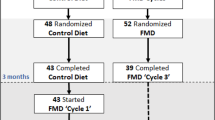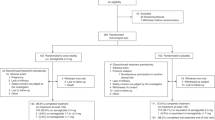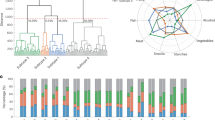Abstract
Previous studies have suggested that whey supplementation may have beneficial effects on lipid profiles, although results were inconsistent. A literature search was performed in March 2015 for randomized controlled trials observing the effects of whey protein and its derivatives on circulating levels of triacylglycerol (TG), total cholesterol (TC), low-density lipoprotein cholesterol (LDL-C) and high-density lipoprotein cholesterol (HDL-C). A meta-analysis was subsequently conducted. The meta-analysis results of 13 trials showed that whey supplementation significantly reduced the circulating TG level by 0.11 mmol/l (95% CI: −0.21, 0 mmol/l), whereas the whey protein had no effects on circulating TC (−0.11 mmol/l, 95% CI: −0.27, 0.05 mmol/l), LDL-C (−0.08 mmol/l, 95% CI: −0.23, 0.07 mmol/l) and HDL-C (0.01 mmol/l, 95% CI: −0.04, 0.05 mmol/l). Subgroup analysis showed that significant TG reduction disappeared in participants with low body mass index, low supplemental whey dose or under exercise training/energy restriction during the trial. No evidence of heterogeneity across studies and publication bias was observed. In conclusion, our findings demonstrated that the effects of whey protein supplementation were modest, with an overall lowering effect on TG but no effect on TC, LDL-C and HDL-C.
This is a preview of subscription content, access via your institution
Access options
Subscribe to this journal
Receive 12 print issues and online access
$259.00 per year
only $21.58 per issue
Buy this article
- Purchase on Springer Link
- Instant access to full article PDF
Prices may be subject to local taxes which are calculated during checkout


Similar content being viewed by others
References
Go AS, Mozaffarian D, Roger VL, Benjamin EJ, Berry JD, Borden WB et al. Heart disease and stroke statistics—2013 update: a report from the American Heart Association. Circulation 2013; 127: 143–152.
Emerging Risk Factors Collaboration, Erqou S, Kaptoge S, Perry PL, Di Angelantonio E, Thompson A, White IR et al. Lipoprotein(a) concentration and the risk of coronary heart disease, stroke, and nonvascular mortality. JAMA 2009; 302: 412–423.
Rahilly-Tierney CR, Lawler EV, Scranton RE, Michael Gaziano J . Low-density lipoprotein reduction and magnitude of cardiovascular risk reduction. Prev Cardiol 2009; 12: 80–87.
Jialal I, Remaley AT . Measurement of low-density lipoprotein cholesterol in assessment and management of cardiovascular disease risk. Clin Pharmacol Ther 2014; 96: 20–22.
Pal S, Radavelli-Bagatini S . The effects of whey protein on cardiometabolic risk factors. Obes Rev 2013; 14: 324–343.
Sousa GT, Lira FS, Rosa JC, de Oliveira EP, Oyama LM, Santos RV et al. Dietary whey protein lessens several risk factors for metabolic diseases: a review. Lipids Health Dis 2012; 11: 67.
Graf S, Egert S, Heer M . Effects of whey protein supplements on metabolism: evidence from human intervention studies. Curr Opin Clin Nutr Metab Care 2011; 14: 569–580.
Tong X, Li W, Xu JY, Han S, Qin LQ . Effects of whey protein and leucine supplementation on insulin resistance in non-obese insulin-resistant model rats. Nutrition 2014; 30: 1076–1080.
Qin LQ, Xu JY, Dong JY, Zhao Y, van Bladeren P, Zhang W . Lactotripeptides intake and blood pressure management: a meta-analysis of randomised controlled clinical trials. Nutr Metab Cardiovasc Dis 2013; 23: 395–402.
Chiu S, Williams PT, Dawson T, Bergman RN, Stefanovski D, Watkins SM et al. Diets high in protein or saturated fat do not affect insulin sensitivity or plasma concentrations of lipids and lipoproteins in overweight and obese adults. J Nutr 2014; 144: 1753–1759.
Gouni-Berthold I, Schulte DM, Krone W, Lapointe JF, Lemieux P, Predel HG et al. The whey fermentation product malleable protein matrix decreases TAG concentrations in patients with the metabolic syndrome: a randomised placebo-controlled trial. Br J Nutr 2012; 107: 1694–1706.
Hambre D, Vergara M, Lood Y, Bachrach-Lindström M, Lindström T, Nystrom FH . A randomized trial of protein supplementation compared with extra fast food on the effects of resistance training to increase metabolism. Scand J Clin Lab Invest 2012; 72: 471–478.
Petyaev IM, Dovgalevsky PY, Klochkov VA, Chalyk NE, Kyle N . Whey protein lycosome formulation improves vascular functions and plasma lipids with reduction of markers of inflammation and oxidative stress in prehypertension. ScientificWorldJournal 2012; 2012: 269476.
Sheikholeslami VD, Kani GFA . Changes in antioxidant status and cardiovascular risk factors of overweight young men after six weeks supplementation of whey protein isolate and resistance training. Appetite 2012; 59: 673–678.
Weinheimer EM, Conley TB, Kobza VM, Sands LP, Lim E, Janle EM et al. Whey protein supplementation does not affect exercise training-induced changes in body composition and indices of metabolic syndrome in middle-aged overweight and obese adults. J Nutr 2012; 142: 1532–1539.
Moher D, Liberati A, Tetzlaff J, Altman DG, PRISMA Group. Preferred reporting items for systematic reviews and meta-analyses: the PRISMA statement. Ann Intern Med 2009; 151: 264–269.
Jadad AR, Moore RA, Carroll D, Jenkinson C, Reynolds DJ, Gavaghan DJ et al. Assessing the quality of reports of randomized clinical trials: is blinding necessary? Control Clin Trials 1996; 17: 1–12.
Higgins J, Green S (eds). Cochrane Handbook for Systematic Reviews of Interventions, Version 502. The Cochrane Collaboration: London, UK, 2009.
Follmann D, Elliott P, Suh I, Cutler J . Variance imputation for overviews of clinical trials with continuous response. J Clin Epidemiol 1992; 45: 769–773.
Higgins JP, Thompson SG . Quantifying heterogeneity in a meta-analysis. Stat Med 2002; 21: 1539–1558.
Egger M, Davey Smith G, Schneider M, Minder C . Bias in meta-analysis detected by a simple, graphical test. BMJ 1997; 315: 629–634.
Berthold HK, Schulte DM, Lapointe JF, Lemieux P, Krone W, Gouni-Berthold I . The whey fermentation product malleable protein matrix decreases triglyceride concentrations in subjects with hypercholesterolemia: a randomized placebo-controlled trial. J Dairy Sci 2011; 94: 589–601.
Pal S, Ellis V, Dhaliwal S . Effects of whey protein isolate on body composition, lipids, insulin and glucose in overweight and obese individuals. Br J Nutr 2010; 104: 716–723.
Claessens M, van Baak MA, Monsheimer S, Saris WH . The effect of a low-fat, high-protein or high-carbohydrate ad libitum diet on weight loss maintenance and metabolic risk factors. Int J Obes 2009; 33: 296–304.
Denysschen CA, Burton HW, Horvath PJ, Leddy JJ, Browne RW . Resistance training with soy vs whey protein supplements in hyperlipidemic males. J Int Soc Sports Nutr 2009; 6: 8.
Frestedt JL, Zenk JL, Kuskowski MA, Ward LS, Bastian ED . A whey-protein supplement increases fat loss and spares lean muscle in obese subjects: a randomized human clinical study. Nutr Metab 2008; 5: 8.
Keogh JB, Clifton P . The effect of meal replacements high in glycomacropeptide on weight loss and markers of cardiovascular disease risk. Am J Clin Nutr 2008; 87: 1602–1605.
Lee YM, Skurk T, Hennig M, Hauner H . Effect of a milk drink supplemented with whey peptides on blood pressure in patients with mild hypertension. Eur J Nutr 2007; 46: 21–27.
Santesso N, Akl EA, Bianchi M, Mente A, Mustafa R, Heels-Ansdell D et al. Effects of higher- versus lower-protein diets on health outcomes: a systematic review and meta-analysis. Eur J Clin Nutr 2012; 66: 780–788.
Dong JY, Zhang ZL, Wang PY, Qin LQ . Effects of high-protein diets on body weight, glycaemic control, blood lipids and blood pressure in type 2 diabetes: meta-analysis of randomised controlled trials. Br J Nutr 2013; 110: 781–789.
Pal S, Ellis V, Ho S . Acute effects of whey protein isolate on cardiovascular risk factors in overweight, postmenopausal women. Atherosclerosis 2010; 212: 339–344.
Mortensen LS, Hartvigsen ML, Brader LJ, Astrup A, Schrezenmeir J, Holst JJ et al. Differential effects of protein quality on postprandial lipemia in response to a fat-rich meal in type 2 diabetes: comparison of whey, casein, gluten, and cod protein. Am J Clin Nutr 2009; 90: 41–48.
Bortolotti M, Maiolo E, Corazza M, Van Dijke E, Schneiter P, Boss A et al. Effects of a whey protein supplementation on intrahepatocellular lipids in obese female patients. Clin Nutr 2011; 30: 494–498.
Hamad EM, Taha SH, Abou Dawood AG, Sitohy MZ, Abdel-Hamid M . Protective effect of whey proteins against nonalcoholic fatty liver in rats. Lipids Health Dis 2011; 10: 57.
Nordestgaard BG, Varbo A . Triglycerides and cardiovascular disease. Lancet 2014; 384: 626–635.
Miller PE, Alexander DD, Perez V . Effects of whey protein and resistance exercise on body composition: a meta-analysis of randomized controlled trials. J Am Coll Nutr 2014; 33: 163–175.
Sawyer L, Kontopidis G . The core lipocalin, bovine beta-lactoglobulin. Biochim Biophys Acta 2000; 1482: 136–148.
Ohlsson L, Hertervig E, Jönsson BA, Duan RD, Nyberg L, Svernlöv R et al. Sphingolipids in human ileostomy content after meals containing milk sphingomyelin. Am J Clin Nutr 2010; 91: 672–678.
Duivenvoorden I, Voshol PJ, Rensen PC, van Duyvenvoorde W, Romijn JA, Emeis JJ et al. Dietary sphingolipids lower plasma cholesterol and triacylglycerol and prevent liver steatosis in APOE*3Leiden mice. Am J Clin Nutr 2006; 84: 312–321.
Chen Q, Reimer RA . Dairy protein and leucine alter GLP-1 release and mRNA of genes involved in intestinal lipid metabolism in vitro. Nutrition 2009; 25: 340–349.
Miller ER 3rd, Erlinger TP, Appel LJ . The effects of macronutrients on blood pressure and lipids: an overview of the DASH and OmniHeart trials. Curr Atheroscler Rep 2006; 8: 460–465.
Hokanson JE, Austin MA . Plasma triglyceride level is a risk factor for cardiovascular disease independent of high-density lipoprotein cholesterol level: a meta-analysis of population-based prospective studies. J Cardiovasc Risk 1996; 3: 213–219.
Acknowledgements
This study was funded by Yili Innovation Center, Inner Mongolia Yili Industrial Group Co., Ltd.
Author contributions
L-QQ and IMYS designed the study; L-QQ developed search strategies and drafted the manuscript; J-WZ and XT completed the literature search and data extraction. ZW, YW and IMYS critically reviewed the manuscript and contributed to the discussion. All authors assisted in the interpretation of the analyses and the revision of the manuscript.
Disclaimer
The funder had no role in study design, data collection and analysis, decision to publish or preparation of the manuscript.
Author information
Authors and Affiliations
Corresponding authors
Ethics declarations
Competing interests
L-QQ received grant support from Yili Innovation Center, Inner Mongolia Yili Industrial Group Co., Ltd., to conduct the review. YW and IMYS are employees of Inner Mongolia Yili Industrial Group Co., Ltd. The remaining authors declare no conflict of interest.
Rights and permissions
About this article
Cite this article
Zhang, JW., Tong, X., Wan, Z. et al. Effect of whey protein on blood lipid profiles: a meta-analysis of randomized controlled trials. Eur J Clin Nutr 70, 879–885 (2016). https://doi.org/10.1038/ejcn.2016.39
Received:
Revised:
Accepted:
Published:
Issue Date:
DOI: https://doi.org/10.1038/ejcn.2016.39
This article is cited by
-
The functionalities and applications of whey/whey protein in fermented foods: a review
Food Science and Biotechnology (2024)
-
Effects of whey protein on glycemic control and serum lipoproteins in patients with metabolic syndrome and related conditions: a systematic review and meta-analysis of randomized controlled clinical trials
Lipids in Health and Disease (2020)
-
Effects of low doses of fish and milk proteins on glucose regulation and markers of insulin sensitivity in overweight adults: a randomised, double blind study
European Journal of Nutrition (2020)
-
Production of Functional Peptide with Anti-obesity Effect from Defatted Tenebrio molitor Larvae Using Proteolytic Enzyme
Biotechnology and Bioprocess Engineering (2020)



